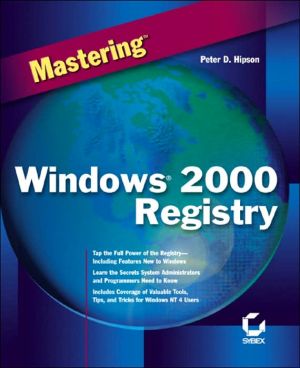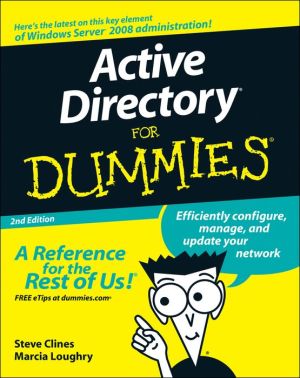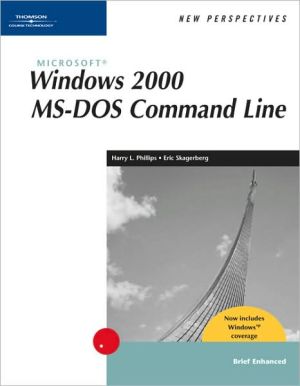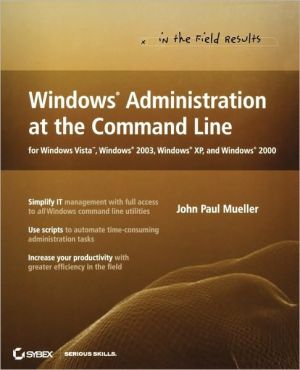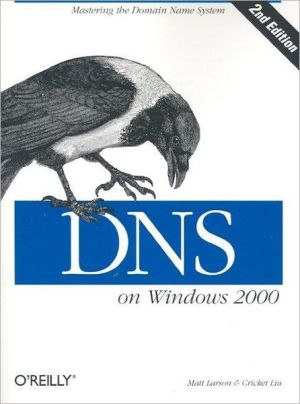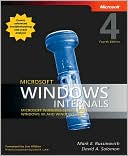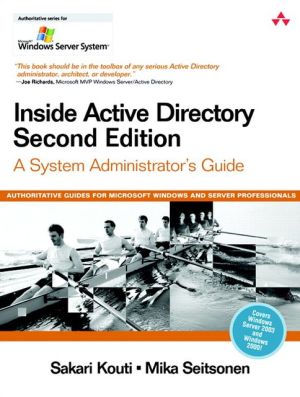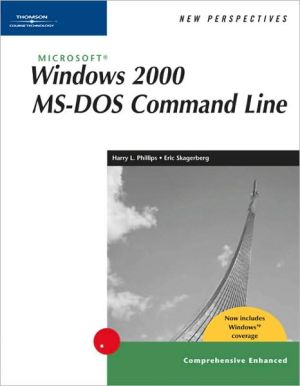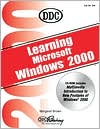Mastering Windows 2000 Registry, Vol. 1
Expert Advice for Windows 2000 Administrators, Programmers, and Power Users\ Mastering Windows 2000 Registry takes you to guruhood fast. Created for experienced system administrators, programmers, and consultants, this reference provides focused coverage of Windows' most important—and most challenging—element: the Registry. Inside, you'll learn to customize Windows 2000, optimize the network, and avoid scores of potential disasters, all by working with Registry settings. If you have to be...
Search in google:
The Windows Registry, a critical file management system for Windows 95, 98, and NT, is a complex and misunderstood element of the Microsoft Operating System architecture. Mastering Windows 2000 Registry teaches readers about the Registry architecture and how it can be monitored and modified to suit their administrative and personal needs. For experienced Windows users moving to the 2000 platform, power users, administrators who manage Windows 2000 and maintain clients, and programmers interested in manipulating the Registry from their applications will find this book to be an essential reference. This book provides total coverage of the Windows 2000 registry, plus scores of undocumented tips and tricks from a Windows master.
\ \ Chapter 9: Recovering From Disaster. or Making the Best of a Bad Situation\ There Is an Error Reading the Drive\ Well, actually this is the beginning of the end of the world.\ First, run chkdsk and determine what Windows 2000 is able to do to fix the problem. Realize that when Windows 2000 fixes a file on an NTFS drive, it doesn't fix the file; it only makes the file readable. Windows 2000 is not able to recover the file's contents-if it could, everything would be all right. Instead, it gives a message that says file so-and-so has been repaired, which is somewhat misleading in this respect. However, you must do this repair to be able to replace the file with the right one.\ When chkdsk runs, it will tell you if there are any damaged files. Windows 2000 is able to recover from minor problems and errors on the drive. Don't worry about these types of errors, it is not unusual to have a drive reported as having minor errors.\ After running chkdsk, you must make a decision. A backup at this point can't hurt, but don't back up over any existing backups. Use a fresh tape, or whatever your backup program backs up to, and put this backup to the side. Here are the actions I'd take, in order of preference:\ 1. Replace the drive and restore to the new drive from the most recent known good backup. Since drives usually fail in stages, a little bit at a time, it is possible that your backups are not going to help as much as you'd like. This is a judgment call-if you are confident that a recent backup is OK, try it. If you are not confident of your more recent backups-often errors develop over time and contaminate all backups long before they are discovered-don't use the backup.\ 2. Reformat the failing drive and restore from a known good backup.\ 3. Restore the entire drive from a known good backup without reformatting. This is sometimes necessary if, for some reason, the drive can't be formatted.\ 4. Try to restore specific files known to be defective, either from backups or from the application's distribution media.\ If there is an error reading the application's files, or the application crashes (faults) when executed, the application's files are probably damaged. What happened? There are a few possibilities. Maybe one or more files were overwritten by user error. As I mentioned earlier, a restore of the application's files will generally allow you to recover from this situation.\ Maybe another application or the operating system overwrote one or more files. Again, check file dates to try to determine when the file overwrites occurred, and see if there is a way to determine the culprit. Restore the correct files and consider setting permissions to read/execute for everyone but an administrative userID that you won't use except to manage these files. Using file system permissions allows you to get immediate notification when a file is overwritten.\ Manually Removing Registry Entries\ In Chapter 8, I described three programs that will automate the process of registry entry removal. But sometimes when repairing a problem, it is necessary to remove entries manually. Here I'll cover manual removal techniques.\ Manual removal techniques are even more dangerous than using a program to clean out entries. Removing things by hand is tedious, and you won't be able to fully check registry integrity this way. Backups are in order before even thinking of starting to manually remove an entry from the registry.\ Finding Entries\ The first thing that you must do is find all the entries relative to the problem. This means you have to do a search.\ Searching the registry with the registry editors is possible but not optimal. RegEdit has the best search capabilities, but rather than using it to search, try the following technique: Launch RegEdit and select My Computer. Next, select Registry - Export Registry File. This will write the entire registry, excluding items such as the security hives, to a text file. Next, use a text editor to find your problem application. Sounds too easy, doesn't it? However, finding the application may present a few problems.\ What do you search for? Try searching for the executable name or directory name. Or try searching for the known name of the application. If none of these work, search for things such as the application's document file extension, if it has one.\ There maybe entries for applications in HKEY_LOCAL_MACHINE\\Software. Many applications install subkeys here, but others do not. If you're looking for a potentially optional component of Windows 2000, check the HKEY_LOCAL_MACHINE\\Software\\Microsoft\\Windows\\CurrentVersion and HKEY_LOCAL_MACHINE\\Software\\Microsoft\\Windows NT\\CurrentVersion subkeys. Virtually everything that is part of the Windows 2000 operating system and from Microsoft should have entries in these two subkeys.\ Still having problems finding your application? Try reading through the registry line by line. Start in the CLSID section, HKEY_LOCAL_MACHINE\\Software\\Classes\\CLSID in HKEY_CLASSES_ROOT.\ Visually scan the registry, starting with HKEY_CLASSES_ROOT, then HKEY_LOCAL_MACHINE, to see if any entries match anything that you can associate with the errant application. Look at the program's name, its publisher-anything that might be a link. At this point, you are in detective mode...
Introduction. Part I: REGISTRY BASICS. Chapter 1: What Is a Registry-and Why? Chapter 2: Readme.1st: Preventing Disaster! Chapter 3: Anatomy of the Registry: The Blood, Gore, and Guts. Chapter 4: Registry Tools and Tips: Getting the Work Done. Chapter 5: Policies, Good for One, Good for All. Part II: ADVANCED REGISTRY STUFF. Chapter 6: Associations, Linkages, and OLE: How Confusing Can This Get? Chapter 7: Why, Oh Why, Are There System.ini and Win.ini Files? Chapter 8: Getting Rid of the Unwanted. Chapter 9: Recovering from Disaster, or Making the Best of a Bad Situation. Chapter 10: Programming and the Registry: A Developer's Paradise? Chapter 11: The Performance Monitor Meets the Registry. Part III: WINDOWS AND OFFICE REGISTRY ENTRIES. Chapter 12: The Windows 2000 User Interface: Changing How It Looks. Chapter 13: Networking and Registry System Entries. Chapter 14: Microsoft Office Entries. Part IV: THE REGISTRY REFERENCE. Chapter 15: Introduction to HKEY_CLASSES_ROOT. Chapter 16: Introduction to HKEY_CURRENT_USER and HKEY_USERS. Chapter 17: Introduction to HKEY_LOCAL_MACHINE. Chapter 18: Introduction to HKEY_LOCAL_MACHINE\\Software. Chapter 19: Introduction to HKEY_LOCAL_MACHINE\\System and HKEY_CURRENT_CONFIG. Appendices. Appendix A: Common Hives and Keys. Appendix B: Registry Data Types. Appendix C: Where Can I Get More Help? Appendix D: Performance Counters. Appendix E: Plug-and-Play Identifiers. Appendix F: Office 2000 CLSIDs. Index.
